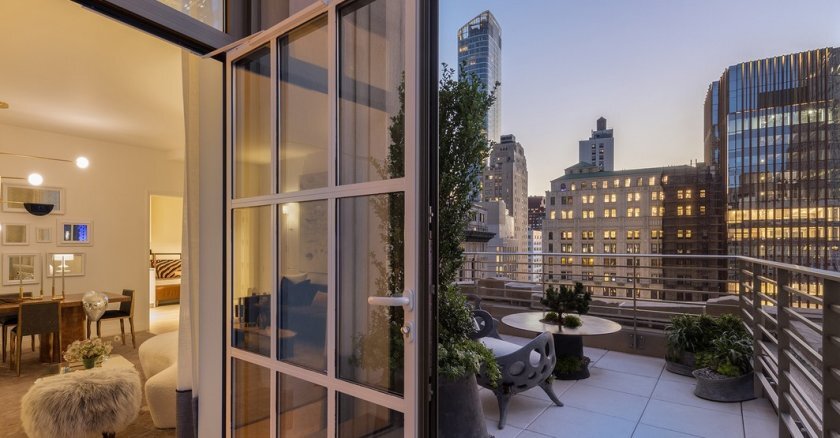
First premise: In the past decade, there has been an increasing desire of young people to live near the center of cities. Second premise: Urban downtowns are overstocked with empty or underused office buildings. Conclusion: Well, you can figure out the conclusion. We should see a substantial conversion of office buildings to apartment buildings and condos.
But is it happening? Yes and no. So far, mostly no.
The emptying out of downtown office buildings is a phenomenon that’s impossible to deny. A quarter of downtown offices are currently thought to be vacant. Gallup tells us that the number of vacancies is higher than at any time in the last 30 years. A poll taken at the end of last year by the Partnership for New York City found that just 8 percent of downtown workers were back in their offices five days a week.
The attraction of young singles and couples to central-city living is equally easy to demonstrate. The residential population of Manhattan’s Financial District has tripled in the last two decades. In 1980, there were 18,000 people living within the boundaries of downtown Chicago. Now there are more than 100,000. Cities as different as Cleveland and Denver have witnessed similar changes. Salt Lake City’s downtown has nearly 4,000 apartments under construction and almost that many proposed. None of this means that millennials are flocking to America’s downtowns en masse. It merely suggests that more of them have wanted to move there than have been able to find appropriate places.
There is a solution to the problem. A study by the Los Angeles real estate industry reported recently that the conversion of hotels and offices to apartments could add 72,000 living units to the area, many of them close to the city center. The New York City real estate board concludes that in midtown Manhattan alone, some 14,000 new residential units could be created.
There is nothing particularly new about the demand for downtown living. Chicago Mayor Richard J. Daley, the elder of the two Daley mayors and not someone renowned as a visionary, realized 60 years ago that the commercial heart of the city could not thrive year-round without a much larger residential population. So he saw to a massive increase in downtown apartment living. Most of this was in newly constructed towers, not converted office buildings. But it was a clear demonstration of how many people wanted to be close to the center. Daley is a large part of the reason central Chicago did not deteriorate like central St. Louis or Detroit.
After the 9/11 disaster, New York City began offering tax subsidies for developers willing to convert old office buildings to residential use. The lower Manhattan Financial District, which had a residential population of about 20,000 at the start of the new century, was up to around 60,000 after little more than a decade. The larger territory of lower Manhattan most recently came in at 298,921.
NOW WE ARE IN AN ENTIRELY NEW ERA, brought about by the coronavirus pandemic and the ensuing expansion of work-at-home employment. It’s true that lots of people moved out of big-city downtowns at the height of the pandemic. But there are plenty of others eager to come in behind them. The ingredients for an office-conversion explosion would seem to be in place. But the evidence for it is decidedly mixed.
On the positive side, the apartment-search site RentCafe predicts that nearly one-quarter of urban adaptive reuse projects in the next several years will come from office buildings. In 2020 and 2021, RentCafe says, 41 percent of all rental apartment conversions in the United States came from offices. Philadelphia alone, RentCafe reports, has redeveloped more than 1,850 apartments, although some of these came from abandoned warehouses and factories, not just office buildings.
RentCafe is something of a cheerleader for office conversions, so it might be wise to treat its statistics as less than definitive. Still, its numbers would seem to suggest a genuine trend. The company says it found more than a thousand office-to-apartment conversions in Washington, D.C., and Chicago in 2020 and 2021, and nearly as many in Los Angeles.
The trouble is that once you move beyond a few cities, conversions are hard to find. There are very few in San Francisco, Seattle or Phoenix, and scarcely any in Houston, even though it had an office vacancy rate of 22.9 percent as of mid-2021.
Why the discrepancy? One reason is that most developers aren’t convinced that office conversions will bring them big profits, at least until they see it happening to somebody else nearby. There’s an old saying that developers make sheep look like independent thinkers. That’s going a bit too far, but it’s still true that the urban real estate development profession is no outpost of entrepreneurial creativity.
THERE IS MORE HOLDING BACK THE CONVERSION PROCESS than developers’ intransigence. The reality is that in many cities in this country, it is still cheaper to build a four- or five-story residential project outside downtown on fresh land than to undertake the conversion of an office tower. In San Francisco, for example, apartment-building conversions have to go through a whole set of earthquake-code regulations, a significant restraining factor.
Something else is at work here. The ideal office building to convert to residential use is a classical or art deco tower, built before World War II. These buildings, besides being visually arresting when cleaned up, generally have floor plans conducive to apartment living, high ceilings and windows that open. Office buildings built in the 1950s or later have none of these qualities. Their floor plans were designed to squeeze the maximum number of people onto each floor, and there isn’t enough natural light in most places. The windows usually don’t open and need to be replaced to meet residential needs. In short, they are no bargain to convert, and for the most part they are not being converted. The easy ones have already been done.
In New York City, where the real estate board has declared that a quarter of the office space in Manhattan could be appropriate for conversion, a recent study by Moody’s in Midtown found that this applied to only 3 percent of the buildings it looked at — just 35 buildings altogether, nearly all older ones. The New York City Department of Buildings reported 100 conversion applications between January of 2020 and June of 2021 — a decent number, but a drop in the bucket for a city that size.
There is one huge Manhattan project that dominates conversion enthusiasm: the flipping of 1.2 million square feet of a 1920s bank tower into 566 apartments at One Wall Street in the shadow of the New York Stock Exchange. It is the largest conversion of its kind in the history of the city. But whether that will encourage more such projects remains to be seen: A 2017 city zoning law made Midtown conversions more difficult in the interest of preventing gentrification and reducing inequality; efforts were made earlier this year at the state level to modify the rules and may have some effect.
AT THE SAME TIME, CONVERSION ENTHUSIASM seems to be taking hold in some cities where you might not expect it. In Dallas, the 36-story Republic Bank building has gone residential, as has the Fidelity Union Life Insurance Tower, with as many as 500 apartments. “Supply creates demand,” one local developer told The Dallas Morning News some years ago. “You have a supply of something that’s worth less than zero, and you have to find something to do with it.”
Similar things are happening in Buffalo, which unlike many large cities has an ample supply of stately 19th- and early-20th-century office towers that could go residential. The current project being watched most closely is the projected conversion of the 1895 building that was vacated by the U.S. Bankruptcy Court. If that conversion goes through, city planners say, it could be a trigger for quite a few more.
But the most important factor, not just in Buffalo or Dallas but in the nation’s largest cities, is commercial rent. In most of them, despite the vacancy rates, rents have not yet fallen enough to convince landlords and developers to do something drastic. They probably will. Gallup projects that 37 percent of currently used office space will be abandoned in the next few years due to employees working at home.
If anything close to that happens, pressure will only grow for the conversion of thousands of downtown office buildings across the country to residential use — even mid-century glass boxes with sealed windows and unwieldy floor designs. In that event, city centers will be taking one large step in an urban evolution that is still underway in its third century.
Related Content













